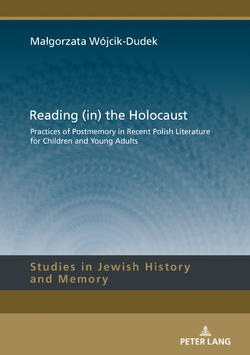Читать книгу Reading (in) the Holocaust - Malgorzata Wójcik-Dudek - Страница 20
На сайте Литреса книга снята с продажи.
Between the See-Saw and the Scaffold: 1946
ОглавлениеSymptomatically, the playground topos undergoes a distinctive reversal in the imaginarium of the Holocaust. A secure, fenced space filled with playthings and resounding with the voices of frolicking kids is one of the canonical instances of childhood imagery. The paradisal site of childhood is replaced by an inverted space – the isolated ghetto, where a place for children to form a community is lacking and toys are lost. The expulsion of the child from the space of play entails not only robbing it of opportunities to satisfy its most natural need, but also pushing it into the adult world, in which it is ruled, as adults are, by the ruthless war-time jurisdiction.108
Considering changes the war made in the rhetorical topoi of childhood, we can usefully draw on two projects aimed at studying and describing the metamorphoses of children’s codes. One of them was initiated by the editors of Przekrój, Poland’s very popular weekly, in 1946, when a competition for children’s drawings of their experiences of the war was announced.109 Two years later, Stefan Szuman, an educational scholar, carried out extensive research on a sample of 2,388 children’s drawings. The pictures were an iconic form of responding to two questions Szuman asked: “My personal memories of the war and occupation” and “What happened to my family and relatives during the war and occupation?”
The war-focused iconographic resources also include an album entitled Wojna w oczach dziecka [The War in the Eyes of a Child], which contains children’s drawings based on reminiscences of their experiences during the war.110 The ←52 | 53→thematically divided pictures are grouped in the following sections: “September,” “Displacement”, “Everyday Life,” “Camps” and “Liberation.” Some of the pictures are accompanied by texts in which the children themselves describe what they lived through during the war. One cannot avoid the impression that the editors of the volume in all probability ignored the actual proportions of drawings concerning respective thematic fields to compose a dramatic but, emphatically, happily ending children’s narrative which unfolds following the fairy-tale sequence of exodus, quest, humiliation, rescue and homecoming. The guiding idea of the volume deserves to be appreciated, for, though perhaps not entirely successful, the book is certainly an original attempt at integrating into official discourse a group of victims and witnesses who have lingered on the peripheries of official narrative. We could even somewhat exaggeratingly refer to this experiment as postcolonial narrative because it opened up a space of memory onto a democratic polyphony of memories in which voices of children could be heard as well, expressive of an inclusive array of symptoms, from the war syndrome and the KZ-syndrome to the trauma of the Holocaust child and the “exiled child” syndrome.111
Even the most cursory look at the album is enough to see that it mercilessly exposes the post-war changes in the spaces of childhood. The idyllic topography is reduced nearly to the point of non-existence, ousted by new war topoi, such as the wall, barbed wire, execution and the gallows. The spaces of war-time childhood as distilled from the drawings leave no room for playgrounds or adult carers – mothers of the playing children. The playground is replaced by the execution square, with the gallows at its centre.112
←53 | 54→
Children’s texts, which often complement picture narratives, also provide interesting material to explore. The texts specify what can only vaguely be inferred from the shapes, colours and/or moods of the drawings. Such small narratives offer an opportunity to articulate details which, though irrelevant to adults, may be vital to children. War-time narratives of children have their young protagonists who populate erstwhile spaces of childhood: “I was crying terribly because auntie didn’t want to take my toys along, nor Bobek my puppy, nor Maciuś, my kitten. Auntie said that we’d leave it all behind, not taking anything with us. When I cried terribly, auntie allowed me to take two dolls, my little black boys, elephants and a few toys,” recalls a young girl named Jadwiga.113
Writing essays about the war not only reminds the children about the loss of their nurseries. It also forces the children to self-referentially revise their narratives as they are being produced: “I can’t write any more, for I miss my daddy so much and I must cry. Why didya [sic] give me such a writing assignment that makes me cry?”114
Was The Academy of Mr Inkblot written for children such as Jadwiga?
